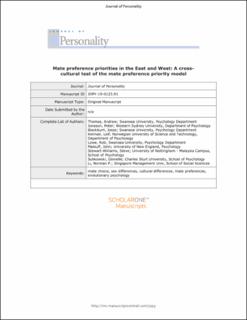Mate preference priorities in the East and West: A cross‐cultural test of the mate preference priority model
Thomas, Andrew G.; Jonason, Peter; Blackburn, Jesse D.; Kennair, Leif Edward Ottesen; Lowe, Rob; Malouff, John; Stewart‐Williams, Steve; Sulikowski, Danielle; Li, Norman P.
Peer reviewed, Journal article
Accepted version

Åpne
Permanent lenke
https://hdl.handle.net/11250/2651652Utgivelsesdato
2019Metadata
Vis full innførselSamlinger
- Institutt for psykologi [3086]
- Publikasjoner fra CRIStin - NTNU [38070]
Originalversjon
10.1111/jopy.12514Sammendrag
Objective
Mate choice involves trading‐off several preferences. Research on this process tends to examine mate preference prioritization in homogenous samples using a small number of traits and thus provide little insight into whether prioritization patterns reflect a universal human nature. This study examined whether prioritization patterns, and their accompanying sex differences, are consistent across Eastern and Western cultures.
Method
In the largest test of the mate preference priority model to date, we asked an international sample of participants (N = 2,477) to design an ideal long‐term partner by allocating mate dollars to eight traits using three budgets. Unlike previous versions of the task, we included traits known to vary in importance by culture (e.g., religiosity and chastity).
Results
Under low budget conditions, Eastern and Western participants differed in their mate dollar allocation for almost every trait (average d = 0.42), indicating that culture influences prioritization. Despite these differences, traits fundamental for the reproductive success of each sex in the ancestral environment were prioritized by both Eastern and Western participants.
Conclusion
The tendency to prioritize reproductively fundamental traits is present in both Eastern and Western cultures. The psychological mechanisms responsible for this process produce similar prioritization patterns despite cross‐cultural variation.